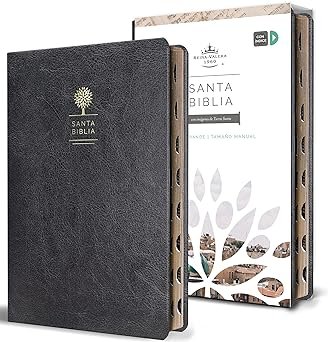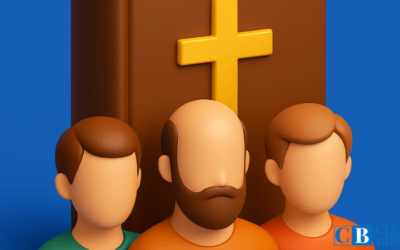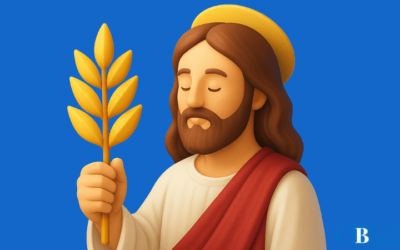What if there was a set of books capable of changing the course of your life and the entire world?
He New Testament It is not just a collection of ancient texts, it is a living revelation that has transformed millions of hearts throughout history.
But what makes it so special? Why has it withstood the test of time, persecution, and criticism?
This set of 27 books, written in a period of less than a century, contains The teachings of Jesus, the birth of the church, and letters that still guide the faith and conduct of millions todayFrom the Gospels to Revelation, every page has an eternal purpose.
In this article we will explore:
- The context in which the New Testament arose
- Its structure and fundamental themes
- The difference between the old and the new covenant
- And why it remains so relevant in the 21st century
Get ready to discover a message that not only informs… but transforms. Are you ready to read the book that changed history?
What is the New Testament and why is it so important?
What if a set of ancient writings could transform your life today?
The New Testament is not just a religious text; it is the heart of Christianity. Comprised of 27 books, it was written by direct witnesses and followers of Jesus Christ, with the purpose of proclaiming his life, death, resurrection, and the eternal significance of his work.
Its importance lies in that:
- Reveals Jesus Christ as the promised Messiah, the Savior of the world.
- Proclaims the gospel of grace, which offers salvation through faith.
- It shows how the first Christians lived and how the church expanded.
- It serves as doctrinal and ethical foundation for millions of believers to this day.
The New Testament not only reports: invites a radical transformation of the heart and lifestyle.
Brief comparison with the Old Testament
Although they form a single Bible, the Old and New Testaments have clear differences and complementary functions.

Both Testaments are intertwined: the Old points to Jesus; the New presents him as the full fulfillment of the plan of redemption.
How many books make up the New Testament and what genres does it include?
The New Testament is composed of 27 books, organized in different literary genres which reflect its theological and pastoral richness.
Classification by gender:
- Gospels (4):
- Matthew, Mark, Luke and John
- They tell the life, teachings, death and resurrection of Jesus
- Historical book (1):
- Acts of the Apostles
- It narrates the expansion of the early church and the ministry of the apostles
- Pauline Epistles (13):
- Romans to Philemon
- Paul's letters to churches and individuals for instruction, exhortation, and correction
- General Epistles (8):
- Hebrews, James, 1-2 Peter, 1-2-3 John, Jude
- Written by other apostolic leaders to a wider audience
- Prophetic Book (1):
- Apocalypse
- Symbolic revelation about the final judgment, the return of Christ, and God's victory
Each of these books serves a specific purpose, but all together reveal the central message of salvation through Jesus Christ and form a coherent and inspired unit.
Historical context of the New Testament
The Greco-Roman world in the time of Jesus and the apostles
The New Testament emerged in a world dominated by the Roman empire, with deep influences from the culture GreekThis context was decisive for the expansion of Christianity:
- He Koine Greek language It was the common language of the empire, which facilitated the spread of the gospels and epistles.
- He Roman road system allowed the apostles to travel and communicate quickly between cities.
- There was a partial religious tolerance, which initially allowed Christians to gather as a Jewish sect before they were persecuted.
- Cities were centers of intellectual life, commerce and religion, where new ideas could spread strongly.
Jesus was born and preached in this complex historical context, and his first followers They used existing structures to bring the gospel to every corner of the known world.
Cultural, religious and political influences
Three pillars directly influenced the New Testament era:
- Greek culture: offered philosophy, literature and logic that influenced the thinking and language of the biblical writers.
- The Jewish religion: It was the root of the Christian faith. The New Testament adopts the knowledge of the Old Testament and practices such as the Mosaic law, the temple, and sacrifices.
- Roman political rule: He imposed taxes, maintained order with military force, and demanded loyalty to the emperor, which caused tensions with Christians, who proclaimed Jesus as Lord.
This intersection of cultures produced an environment where The proclamation of a crucified and risen Savior generated impact, confrontation and conversion.
The transition from Judaism to early Christianity
Christianity did not emerge as a new, isolated religion, but as the fulfillment of the promises of Judaism. However, over time it developed its own identity:
- The first Christians were Jews who recognized Jesus as the Messiah.
- They met in synagogues and followed Jewish customs, although reinterpreted in the light of Christ (Acts 2:46).
- The inclusion of Gentiles (non-Jews) without the need for circumcision or Mosaic law was key (Acts 15), generating tension with traditionalist Jews.
- Little by little, the church was consolidated as an independent body, with its own theology, practices, leadership and missionary vision.
This transition was progressive, painful and deeply theological, marking the emergence of a global faith centered on the figure of Christ.
Formation and transmission of the New Testament
When and how were the books of the New Testament written?
The books of the New Testament were written between the years 45 and 100 AD, by apostles and direct witnesses of the events narrated.
- The Gospels They were written between the years 60 and 90 AD, based on oral traditions and eyewitness accounts.
- The epistles of Paul They are the oldest (some written around 50 AD), addressed to specific churches.
- Apocalypse It was probably the last book, written by the apostle John on the island of Patmos.
The authors wrote in response to specific needs: correct errors, strengthen faith, preserve teachings and bear witness to the risen Christ.
The process of copying and preserving manuscripts
Since there was no printing press, the New Testament texts were copied by hand by Christian scribes.
Characteristics of this process:
- The first copies were made in papyrus, a brittle material, and later in parchment, more durable.
- They were distributed in churches, where they they read aloud and were kept as sacred treasures (Colossians 4:16).
- Despite minor copying errors, the high number of manuscripts (more than 5,800 Greek) allows reconstruct the original text with great precision.
- Fragments of the New Testament have been found less than 100 years after its writing, which is exceptional in ancient literature.
This collective effort shows that The early church recognized from the beginning the inspirational and authoritative value of these writings.
The New Testament canon: Who decided which books to include?
He canon It is the set of books recognized as inspired by God. The formation of the New Testament canon was a process guided by the Holy Spirit through the Christian community.
Criteria used:
- Apostolic authorship or direct connection with an apostle (Matthew, Paul, Peter, John).
- Doctrinal conformity with the message of Christ.
- Liturgical and continuous use in churches since the early centuries.
- Confirmation by the Holy Spirit in the hearts of believers.
Important milestones:
- By the end of the 2nd century, there was already a consensus on most books.
- He Muratorian Canon (2nd century) and the Councils of Hippo (393) and Carthage (397) confirmed the 27 books that we know today.
It was not an arbitrary decision, but a recognition of what the church already lived and used as the Word of God.
Structure of the New Testament
The Gospels: Four Perspectives on Jesus
The New Testament begins with four Gospels: Matthew, Mark, Luke and John. Each one presents a complementary portrait of Jesus, highlighting different aspects of its identity and mission.
- Matthew: written for a Jewish audience, presents Jesus as the Promised Messiah and new Moses.
- Marcos: the shortest and most direct, shows Jesus as the Suffering and powerful servant.
- Luke: addressed to the Gentiles, highlights Jesus as Universal and compassionate savior.
- Juan: offers a more theological view, presenting Jesus as the Eternal Word made flesh.
Although different in style, All affirm the divinity of Jesus, his redemptive work, and his call to discipleship..
The Book of Acts: Expansion of the Early Church
Acts of the Apostles, written by Luke, is the bridge between the Gospels and the Epistles. It narrates how the Holy Spirit prompted the spread of the gospel from Jerusalem to Rome.
Main topics:
- The outpouring of the Holy Spirit at Pentecost (Acts 2).
- Peter's speeches and apostolic leadership.
- Paul's conversion and mission.
- Church growth despite persecution.
Facts are key to understanding How Christianity spread in the ancient world and how the churches addressed in the epistles arose.
The Pauline Epistles: Theology, Exhortation, and Christian Life
The 13 letters of Paul They were addressed to specific churches or individuals, dealing with doctrinal, ethical, and pastoral issues.
They are divided into three groups:
- Epistles to churches: Romans, Corinthians, Galatians, Ephesians, Philippians, Colossians, Thessalonians.
- Pastoral Epistles: 1 and 2 Timothy, Titus.
- Personal letter: Philemon.
Highlighted contributions:
- Justification by faith (Romans, Galatians).
- Unity of the body of Christ (Ephesians).
- Joy in the midst of trial (Philippians).
- Tips for leaders and discipleship (Timothy and Titus).
Paul teaches that The gospel transforms both the mind and the behavior of the believer.
The General Epistles: Teaching for the Whole Church
These letters, not written by Paul, are addressed to a broad audience and deal with topics common to all believers.
They include:
- Hebrews: presents Christ as High Priest and mediator of the new covenant.
- Santiago: emphasizes that the True faith is demonstrated by works.
- Peter: calls for hope and holiness in the midst of suffering.
- Juan: highlights love, truth, and the fight against false teachers.
- Judas: urges contend for the faith in the face of apostasy.
These letters are deeply pastoral and practical, aimed at strengthening the universal church.
Revelation: Prophetic Revelation and Future Hope
The book of Revelation, written by John, is a symbolic and prophetic revelation about the final victory of Christ.
Main themes:
- The throne of God and heavenly worship.
- The spiritual conflict between good and evil.
- Judgment against the enemies of God.
- The Second Coming of Christ and the New Creation.
Revelation is not just a book of the “end of times,” but a source of hope and perseverance for persecuted believers.
Key themes of the New Testament
The life, death and resurrection of Jesus Christ
The heart of the New Testament is the person and work of JesusHis life was holy, his death was redemptive, and his resurrection was glorious.
Importance:
- He fulfilled the prophecies of the Old Testament.
- He died as the perfect sacrifice for sin (Hebrews 9:26).
- He rose again on the third day, conquering death (1 Corinthians 15:3-4).
- He was exalted and will return in glory (Philippians 2:9-11).
His work establishes the new pact and opens the way to reconciliation with God.
Salvation by grace through faith
One of the most revolutionary messages of the New Testament is that the Salvation is not earned, it is received.
Fundamentals:
- “By grace you have been saved through faith…” (Ephesians 2:8-9).
- Justification comes by believing, not by keeping the law (Romans 3:28).
- True faith produces obedience and visible fruits (Galatians 5:6).
This message breaks with human merit and proclaims divine generosity in Christ.
The Kingdom of God and the Second Coming of Christ
Jesus preached that the Kingdom of God had arrived, but its fullness was yet to come.
Aspects of the kingdom:
- Present: when the believer obeys Christ as King.
- Future: when Christ returns and establishes his final dominion.
- Hope: the promise of justice, restoration, and eternal life (2 Peter 3:13).
The New Testament exhorts us to live in holiness and vigilance, waiting with faith for the Lord's return.
The Christian Life: Ethics, Community, and Transformation
Believers are called to a new life that reflects Christ in every aspect.
Promoted values:
- Love, humility, forgiveness, patience (Colossians 3:12-14).
- Community life, generosity and unity (Acts 2:42-47).
- Rejection of sin, self-control, practical holiness (Ephesians 4–5).
Faith is not just belief: It is a way of life guided by the Spirit.
The Holy Spirit in the believer's experience
The Holy Spirit is protagonist in the New Testament, working in and through Christians.
Functions of the Spirit:
- Convicts of sin and regenerates (John 16:8; Titus 3:5).
- He dwells in believers as a seal of salvation (Ephesians 1:13-14).
- It gives power to witness, gifts to serve, and fruit to grow (Acts 1:8; 1 Corinthians 12; Galatians 5:22-23).
The Holy Spirit is the faithful companion of the believer, who guides him into all truth and transforms him into the image of Christ.
Main characters of the New Testament
Jesus of Nazareth: Son of God and promised Messiah
Jesus is the central figure of the New TestamentHis life, teachings, miracles, death, and resurrection are the axis around which the entire Christian message revolves.
Key aspects:
- Miraculous birth (Matthew 1:18-25) and fulfillment of messianic prophecies.
- Powerful Teachings and Parables that reveal the character of the Kingdom of God.
- Miracles as signs of his divine authority.
- Voluntary crucifixion as an atoning sacrifice for sin (Isaiah 53, Hebrews 10).
- Resurrection and Ascension as proof of his victory over death and his exaltation (Acts 1:9).
Jesus is not just a teacher or prophet: he is the Son of God incarnate, Savior and eternal King.
The apostles: Peter, John, James and others
The twelve apostles were the main witnesses of Jesus' ministry and the pillars of the early church.
Prominent figures:
- Peter: impulsive but firm, leader in the church of Jerusalem, preacher at Pentecost and author of two epistles.
- Juan: “the beloved disciple”, eyewitness, author of the Gospel that bears his name, three letters and the Apocalypse.
- Santiago (brother of John): early martyr (Acts 12:2).
- Thomas: initially an incredulous person, then a fervent witness.
- Andrew, Philip, Bartholomew, Matthew, Simon, Judas Thaddeus and others: also sent to preach the gospel with power.
After the resurrection, these men were empowered by the Holy Spirit and carried the message to the ends of the Empire.
The Apostle Paul: life, conversion and mission
Paul, formerly Saul of Tarsus, was a persecutor of Christians who became the most influential missionary and theologian of early Christianity.
Decisive moments:
- Encounter with the Risen Christ on the road to Damascus (Acts 9).
- Called as apostle to the Gentiles, with multiple missionary trips.
- Author of 13 epistles of the New Testament, where he sets forth the doctrine of justification by faith, grace, and life in the Spirit.
- Imprisoned, persecuted and finally martyred in Rome.
Paul's life shows that No one is beyond the reach of God's grace, and his work forms the basis of Western Christian thought.
Relevance of the New Testament today
Why is it still relevant and transformative?
Although written almost two thousand years ago, the New Testament continues to speak with power to modern man.
Reasons for its validity:
- Treats universal themes: love, sin, forgiveness, purpose, suffering, hope.
- Presents a unique answer to the human dilemma: reconciliation with God through Jesus Christ.
- Invite a deep internal transformation through the power of the Holy Spirit.
The New Testament It does not go out of style because it deals with eternal truths applicable to any era, culture and generation.
The impact of the New Testament on culture and history
No other set of writings has had so much impact on the history of humanity like the New Testament.
Cultural evidence:
- Inspired art, music, architecture and literature for centuries (The Last Supper, Handel's Messiah, etc.).
- Basis of ethical and legal values in many Western societies.
- Engine of humanitarian, missionary and educational movements at a global level.
- He transformed entire nations, inspired the Protestant Reformation and remains the subject of academic study in universities.
The New Testament not only changed individuals: shaped civilizations.
How to apply his teachings in daily life
The message of the New Testament is not meant to remain on paper: it must be lived and reflected daily.
Practical ways of application:
- Love God and neighbor as the basis of all action (Matthew 22:37-39).
- Practice forgiveness, humility, and generosity in our relationships (Ephesians 4:32).
- Seek the truth and reject evil in personal, work and family decisions (Romans 12:2).
- Remain firm in the faith and share the gospel with courage (1 Peter 3:15).
Studying and applying the New Testament is open to a life guided by the Spirit, centered on Christ and committed to the common good.
Key differences between the Old and New Testaments
The Old Covenant vs. the New Covenant
The Old Testament presents the covenant between God and the people of Israel, based on obedience to the law given to Moses. The New Testament introduces a new pact, established by Jesus Christ, open to all humanity.
Fundamental differences:
- He ancient pact required obedience to external commandments and ceremonial rites.
- He new pact, promised in Jeremiah 31:31-34, offers a inner relationship with God, based on faith in Christ.
- In the new covenant, God He writes his law on hearts and offers complete forgiveness through Jesus' sacrifice.
This change represents a spiritual revolution, moving from a system based on merit to one based on grace.
The Mosaic Law and the Grace of Christ
The Mosaic Law (Torah) regulated all aspects of Israel's life: moral, civil, and ceremonial. It was holy and just, but also pointed out the human impossibility of fulfilling it perfectly.
With the coming of Christ:
- The law is fully fulfilled in Him (Matthew 5:17).
- Salvation no longer depends on complying with regulations, but of the undeserved grace (Romans 6:14).
- Obedience arises not by legal obligation, but as a fruit of a relationship with God through the Holy Spirit (Galatians 5:18).
Grace does not cancel out holiness, but empowers the believer to live according to God's will.
Ritual sacrifices vs. the ultimate sacrifice of Jesus
In the Old Testament, animal sacrifices were temporary symbols which covered sin, but could not completely take it away (Hebrews 10:1-4).
With Jesus:
- It is offered himself as a perfect sacrifice, once and for all (Hebrews 10:10-14).
- His blood not only covers, but cleans completely sin.
- The Temple and the Levitical Priesthood are replaced for his eternal work as Heavenly High Priest.
This marks a transition from the symbol to the ultimate spiritual reality, accessible to all believers.
The New Testament and the unity of the Bible
How it connects to Old Testament prophecies
The New Testament does not break with the Old, but continues it and fulfills it. Jesus and the apostles constantly quote the Hebrew Scriptures as prophetic authority.
Examples of compliance:
- Virgin birth of Jesus (Isaiah 7:14; Matthew 1:22-23).
- Ministry in Galilee (Isaiah 9:1-2; Matthew 4:13-16).
- Crucifixion and suffering of the Messiah (Psalm 22; Isaiah 53; Acts 8:32-35).
- Resurrection (Psalm 16:10; Acts 2:25-31).
These connections show that The Bible is one redemptive story, which finds its culmination in Christ.
The continuity of the divine plan of redemption
From Genesis to Revelation, the Bible reveals a coherent plan of salvation, designed by God from eternity.
Elements of the plan:
- The promise to Abraham: a blessing for all nations (Genesis 12:3).
- The Law and the Prophets: preparation for the Messiah.
- Jesus: fulfillment, mediator of the new covenant and restorer of all things.
- The church: bearer of the gospel until Christ's return.
- Apocalypse: final consummation with a new heaven and a new earth.
Nothing in biblical history is accidental: Everything points to God's redemptive work through Christ.
The figure of Christ as the fulfillment of the promises
Jesus does not only appear in the New Testament: It is present in shadow and promise from the beginning.
Christ fulfills:
- The role of prophet as God's final spokesman (Deuteronomy 18:15; Hebrews 1:1-2).
- The role of priest as mediator between God and men (Psalm 110:4; Hebrews 5:5-10).
- The role of king as heir to the throne of David (2 Samuel 7:12-14; Luke 1:32-33).
- The promises of the covenant made to Abraham, Moses and David.
In Jesus they converge all the hopes of Israel and all the need for redemption of humanityHe is the common thread that unites the entire Bible.
Book recommendations for further study
📘 “Greek-Spanish Interlinear New Testament” – Francisco Lacueva
Ideal for those who want to go beyond translation. This book offers the original Greek text along with its English equivalent, allowing for a deep linguistic analysis, useful for exegetical studies and contextual preaching.
📘 “The Message of the New Testament” – John Stott
A clear, theological and pastoral work that presents the doctrinal and spiritual core of each book from the New Testament. Perfect for both leaders and believers who want to understand the purpose and central message of each inspired writing.
📘 “Halley’s Bible Handbook” – Henry H. Halley
A complete guide with summaries, chronologies, maps, historical contexts and simple comments on all the biblical books, including the New Testament. Very useful for personal devotionals, group studies, and church teaching.
Frequently Asked Questions About the New Testament
What is the purpose of the New Testament?
To proclaim Jesus Christ as the Son of God, to present his life, death, and resurrection, and to establish the doctrinal and practical foundation of the Christian faith for the church.
What books are included and in what order?
The New Testament contains 27 books: 4 gospels, 1 historical book (Acts), 13 Pauline epistles, 8 general epistles, and 1 prophetic book (Revelation). The usual order begins with Matthew and concludes with Revelation.
Why are there four gospels and not just one?
Each gospel offers a different perspective of Jesus himself, adapted to different audiences and purposes. Together, they provide a more complete and enriching portrait of the Savior.
What evidence exists of its historical authenticity?
Thousands of ancient manuscripts, testimonies of the church fathers, internal consistency and historical cross-references support its textual and historical reliability. Moreover, many of its authors were eyewitnesses.
What is the central message of the New Testament?
Jesus is the Son of God and Savior, and through his death and resurrection offers salvation by grace, through faith, restoring the relationship between God and humanity.
What are the differences between the Pauline and general epistles?
The Pauline Epistles are letters from Paul to specific churches or individuals, with a doctrinal and pastoral focus. The general epistles were written by other apostles and are addressed to the universal church, with broader and more practical teachings.
How was the Apocalypse written and what does it mean?
Revelation was written by the apostle John on the island of Patmos, as a symbolic revelation given by Christ. It contains messages to the churches, visions of the final judgment and God's victory, offering hope in the midst of persecution.
What role does the New Testament play in the Christian faith?
It is the doctrinal foundation of the Christian faith, revealing the gospel, the new life in Christ, and the mission of the church. Without the New Testament, the message of salvation would remain incomplete.
What is the best method to study it?
He inductive method It is highly recommended to observe the text, interpret the context, and apply its teachings. It is also helpful to accompany it with prayer, group study, and good Bible commentary.
Why is it important to know the cultural context of the New Testament?
The cultural context helps us to correctly interpret words, customs and situations of the texts. Understanding the authors' historical, religious, and social context illuminates the original message and its application today.
Conclusion
The New Testament is not simply a religious text or a historical document: it is a open door to a living relationship with God, a practical guide for daily life and an inexhaustible source of eternal hope. Through its pages, we come to know Jesus, understand the purpose of salvation, and discover how to live with faith, grace, and truth in the midst of a changing world.
Whether you are reading it for the first time or have studied it for years, Every encounter with the New Testament has the power to renew your mind and transform your heart.His message remains as relevant today as it was two thousand years ago.
And you, What part of the New Testament has impacted your life the most or raises the most questions?
Leave it in the comments and share your experience with other readers. Let's read and learn together!
Discover How the Bible Can Transform Your Life
- Bible Study – explore the teachings of the Bible and find answers to life’s challenges.
- Fundamental Beliefs – delves into the principles that have guided millions through the centuries.
- Spiritual Growth – Strengthen your faith with studies designed to bring you closer to God.

Discover How the Bible Can Transform Your Life
- Bible Study – explore the teachings of the Bible and find answers to life’s challenges.
- Fundamental Beliefs – delves into the principles that have guided millions through the centuries.
- Spiritual Growth – Strengthen your faith with studies designed to bring you closer to God.



























0 Comments